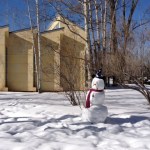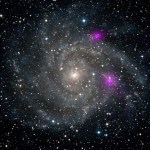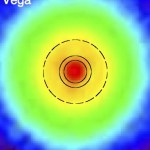
"Not one penny..."!!!
My Precious vanished...
My Precious!
and then...
Kidnapped! Thieves!
desperate times indeed.
But the ass. made one critical mistake..
while they were distracted by some science bits, it being proposal season, you know, they left their lair unguarded, and our superbly NASA-trained team of astro ninjas carried out a successful extraction!
They'll now just have to take their chances in the NSF and ROSES lottery like everyone else.
Time magazine just ran an article "Cosmic Fuggedaboudit: Dark Matter May Not Exist At All" - a revisit of the MOND hypothesis.
The story keys off the recent article by Ibata on the Andromeda dwarf galaxies (sub) arXiv pdf, and here is the full ApJ article on arXiv.
Independent of these recent developments, it highlights the continued persistence of the notion that maybe Cold Dark Matter needs to be revisited.
Sean had good discussion of the issues over at Cosmic Variance last year, and recently Kroupa started a blog, the The Dark Matter Crisis, now at scilogs.com/the-dark-matter-crisis/
For…
A couple of astrostatistics related announcements:
1) The Astrostatistics & Astroinformatics Portal is open.
"The ASAIP provides searchable abstracts to Recent Papers in the field, several discussion Forums, various resources for researchers, brief Articles by experts, and lists of Meetings. The site will be used for public outreach by four organizations: International Astrostatistics Association (IAA, to be affiliated with the International Statistical Institute), American Astronomical Society Working Group in Astroinformatics and Astrostatistics, International Astronomical Union…
Earth Impact Calculator
Ok, that was close, and I don't mean the zip by of li'l old 2012 DA14 this evening.
The Chelyabinsk meteor looks to have been on the high end of the range of quick and dirty estimates, with impact energy of maybe 300 kTon equivalent. This is a size impact we'd expect every few decades, maybe, quite a bit smaller than Tunguska, but larger than anything we know of in the last 20 years.
Meteors come in with speeds ranging from 10-70 km/sec.
This one appears to have had a speed of ~ 20 km/sec, which gives it kinetic energy of 2*108 J/kg
As you know, the handy unit here…
A bolide hit the Earth over Russia, breaking up at low altitude, causing a strong shock that reached the ground causing damage.
There are reports of some fragments hitting the ground.
Good summary and videos at The Age
video from Russia Today
the fragments will be valuable and probably show up soon on ebay
there was no shootdown, the breakup is normal when the meteorite gets lower down into the atmosphere.
There are no issues with radiation [sic]
looks like a fairly slow shallow angle impact, detonating with kiloton++ energy below few km altitude - guessing from the video
that'd make it a…
The shadow of a shadow of a planet... and other fun Kepler discoveries
Exoplanets in Multi-body Systems in the Kepler Era is a conference currently under way at the Aspen Center for Physics
Physicists hard at work
The meeting is very vibrant, with a mostly very young crowd of active researchers.
There have been a number of very interesting talks reporting some very interesting discoveries, many of which are embargoed...
One, still unpublished discovery, from Josh Carter et al, for a KOI-not-to-be-named, used transit geometry from two planets and measurements of the stellar spin from…
Ok - I'm crowdsourcing the internet, because the google has failed:
there are two science fiction short stories that I need titles and authors for, source in anthology or collection would be better still.
1) humans in slower-than-light spaceship set out to colonize planet identified around nearby star. When they finally get there, they find the planet already colonized by humans, who had left after them but on a faster (ftl?) spaceship and arrived before them
2) humans expand around galaxy and find no intelligent life - finally contact is made, arrangements are set up to treat with aliens,…
Our future foretell
Galaxies of stellar poems
From space science spring
Inspired by Jason Wright's Thesis, Lucianne Walkowicz called out Astronomers on facebook to describe their current research as Haiku
To the Occasion
All Astronomers Sprung Forth
Poetic Research
There is a collection of some of the contributions at
Rhymes Like Science
Where my feeble efforts fall
Amongst stellar prose
Dynamics of Cats
Cold winter sky glow
crushed stars dance in my dreams
where will life go now?
Clearly this can be expanded on: we need iambic pentameter, limericks, and poetry of the sagas - proper…
The Aspen Center for Physics does a number of public outreach and engagement activities.
A new and quite interesting effort underway is Radio Physics, in collaboration with KDNK community radio.
The project links (visiting) physicists with local AP physics classes, who do a 30 minute group interview, live, on the topic du jour.
When available in person, the interview is preceded by a mini-physics cafe, where the whole class meets with the victim at a local coffee shop and gets to quiz them on pretty much anything.
And, of course, the whole thing is not just broadcast live, but archived for…
The "Physical Applications of Millisecond Pulsars" conference is under way at the Aspen Center for Physics, going through thursday when the X-Games take over.
The meeting started with surveys of current observational and instrumentation projects, in particular the amazing serendipitous discoveries being made by NASA's Fermi γ-ray observatory, in conjunction with ground based radio telescopes, and the new observatories being built.
This was followed by a session on pulsar magnetospheric physics, optical companions to pulsars and other goodies.
Today we get tests of theories of gravity, and…
astropixie has running update on the Siding Spring Observatory Fire in Warrumbungle National Park in Australia.
PS: Day After the Fire update from astropixie - telescopes mostly ok, astronomy facilities not so much
#ClimateChange
Gemini AO LASER
As we come to the end of the 221st annual meeting of the American Astronomical Society, it is time to reflect upon the diverse science presented at the meeting.
And what a lot of science it was.
Fortunately, there were also a lot of people to make sense of it and press releases picked out for us to highlight that thought to be most likely to be of public interest.
Which is a good thing, partly because I was kept overly busy talking to prospie grads and assorted post-graduate job candidates.
I think I even got a chance to chat with some old friends, just to catch up.
Emily…
The AAS felt curiously light on major news this year.
Not that there weren't a lot of developments and announcements of results, rather that there didn't seem to any major obvious breakthroughs.
Of course, it is the little ones that get you...
Critically there is, of course, the annual, informal contest for the "best swag".
After the LSST pedometer in 2010 (back this year and still popular),
and the Ball Aerospace Alien Mobile in 2011 (also back this year),
I missed 2012 :-(
But, Duilia del Mello was there, and found the NASA ScreenClean (indispensable).
This year, well, we go with Duilia's…
The James Webb Space Telescope is large, overbudget and in a category of its own.
Literally.
And now stirring over some controversy as the reality of science funding starts smacking scientists in the face.
Last year, as I'm, sure you remember, the JWST funding line was take out of the Astrophysics Division and segregated in its own division, a funding maneuver that has been used before for large overruning projects.
This, incidentally, brutally exposed how tight the space science budgets have been squeezed, partly through overruns, partly through tough little missions hanging on longer than…
Space based infrared observations find double planetesimal belts around Vega.
Vega
Su et al. (ApJ in press) got Spitzer and Herschel observations of Vega, and find emission consistent with an inner warm asteroid belt and an outer cool planetesimal belt, with a gap between.
Vega
This is similar to what we see in the Solar System but on a bigger scale around a younger, hotter, more massive star.
The inference is that the gap between the two belts is kept clear of tepid dust by multiple planets orbiting in the region.
Schematic of Vega system inferred from observations
This is a very cool…
On the Blues and the Lifestyles and Fates of the Hottest Stars as they Cluster in the Heavens: or, why aging gracefully depends on your lifestyle and environment...
The Stellar Dynamical Clock
- is a Nature paper that came out in the Christmas double issue, always my favourite and very good value, might I add.
This paper is from a long term collaboration lead by Prof. Francesco Ferraro which over many cycles has built up a systematic sample of Hubble Space Telescope images of Galactic Globular Clusters, focusing, in partiular, on the blue and UV emitters in the dense cores of clusters, but…
It was at the gathering,
and all the astronomers were there,
drinking coffee among the posters,
hearing the NSF in despair...
I am at my almost regular pilgrimage to the Annual Meeting of the American Astronomical Society, where I hope to do some semi-liveblogging of developments and science news in my copious spare time.
I have more tasks than usual at this meeting, as not only am I, and my student, giving talks, I am also doing recruiting for prospective graduate students, postdoctoral hires and faculty, and attending the informal gathering of the ApJ editors.
I would also go to The Party,…
Hubble's Constant: H0 = 42!
42 scots miles/sec/Mpc that is.
Finally we know the natural units for cosmology.
The venerable Astrophysical Journal, Letters has a new editor: Prof. Fred Rasio.
Fred is the 4th editor in the journal's 45 year existence. The Letters are for the publication of rapid, short papers, which are timely, and often somewhat speculative.
Fred takes over from Chris Sneden, who did a fabulous job over the last decade, having replaced Alexander Dalgarno, who reigned over the Letters for three decades, having taken over from the first editor, Don Osterbrock when Don became Director of Lick Observatory.
Fred has published the traditional First Editorial - editorials by actual editors…
More Phenomenal random links to random stuff: life, the Universe and Everything
Phenomena - new blog group under National Geographic, including some long time scibloggers: The Loom, Not Exactly Rocket Science, Laelaps and Only Human, to begin with.
On the Usefulness of Useless Knowledge - Bee explains.
Substantive Advice to Admissions Committees - Or, why, all things being equal, we should prefer candidates from less prestigious institutions.
This is actually sensible - it is a "what have you done with what you were given" argument.
But, all things are very rarely equal... and no one ever…




